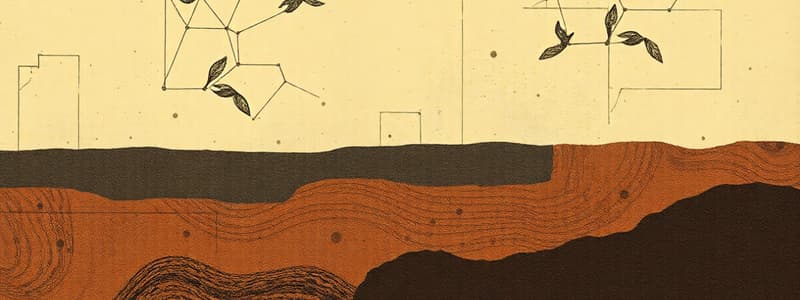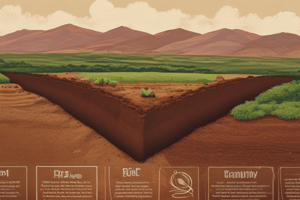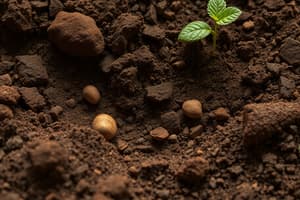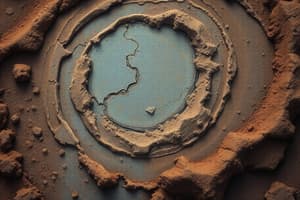Podcast
Questions and Answers
What characteristics define sandy loam soil?
What characteristics define sandy loam soil?
Sandy loam contains more silt and clay than loamy sand, with a smooth texture and large aggregates.
How does the composition of loam soil affect its properties when moist?
How does the composition of loam soil affect its properties when moist?
Loam soil exhibits cohesive properties, becoming sticky and plastic when moist due to its sand and clay components.
What is the significance of silt in soil texture?
What is the significance of silt in soil texture?
Silt has a very fine particle size, providing a large surface area for physical and chemical activities in the soil.
Explain the difference between clay and clay loam in terms of their texture and behavior.
Explain the difference between clay and clay loam in terms of their texture and behavior.
What role does water availability play in microbial activity in soil?
What role does water availability play in microbial activity in soil?
Describe the texture and nutrient content of peat or muck soils.
Describe the texture and nutrient content of peat or muck soils.
What is the texture of silt loam and how does it behave when moist?
What is the texture of silt loam and how does it behave when moist?
How does soil texture influence the water retention properties of sandy clay loam?
How does soil texture influence the water retention properties of sandy clay loam?
What soil type is characterized by having up to 50% silt and 25% clay, primarily influenced by sand and clay properties?
What soil type is characterized by having up to 50% silt and 25% clay, primarily influenced by sand and clay properties?
Which soil type possesses the smallest particles and is known for its immense surface area for chemical reactions?
Which soil type possesses the smallest particles and is known for its immense surface area for chemical reactions?
Describe the behavior of silty clay when it is wet and dry.
Describe the behavior of silty clay when it is wet and dry.
What environmental factors are crucial for influencing microbial activity in soil?
What environmental factors are crucial for influencing microbial activity in soil?
How does loamy sand differ from sandy loam in terms of silt and clay content?
How does loamy sand differ from sandy loam in terms of silt and clay content?
What is the main characteristic of peat or muck soils?
What is the main characteristic of peat or muck soils?
What are the primary properties of sandy clay loam?
What are the primary properties of sandy clay loam?
Explain the texture and behavior of clay soil when moist.
Explain the texture and behavior of clay soil when moist.
Flashcards are hidden until you start studying
Study Notes
Soil Texture
-
- Sand: The largest particles within the soil category, sand is characterized by its coarse, gritty texture that feels rough to the touch. These particles are typically larger than those found in other soil types, such as silt and clay, which contributes to their distinct properties. Due to their size and shape, sand particles do not stick together easily. This intrinsic lack of cohesion results in sandy soils having poor structural integrity when dry, causing them to drain quickly. However, when moisture is introduced, sand particles demonstrate an improved ability to hold together momentarily, leading to a temporary increase in soil stability.
- Loamy Sand: This type of soil features a higher proportion of silt and clay particles compared to pure sand. As a result of this composition, loamy sand possesses a greater ability to retain moisture and nutrient elements than coarse sand alone. When moistened, loamy sand can be easily molded or shaped, making it favorable for various agricultural practices where soil structure is important for seed germination and root development.
- Sandy Loam: Sandy loam comprises an even greater amount of silt and clay in comparison to loamy sand. The texture of sandy loam is smooth and silky to the touch, offering an optimal balance between drainage and moisture retention. This type of soil forms larger aggregates that promote aeration and root penetration, creating an ideal growing environment for many crops and vegetation.
- Loam: This soil type is often considered one of the most fertile and is composed of a balanced mix of sand, silt, and clay. The combination results in a soft and smooth, powder-like texture that retains both moisture and nutrients effectively. Loam is prized in agriculture for its ability to support healthy plant growth while also facilitating excellent drainage, which prevents waterlogging and root rot.
- Silt: As the smallest soil particles, silt is extremely fine and contributes significantly to the soil's overall texture and characteristics. Silt particles have a unique capability to form hard aggregates when dry and become very sticky when wet, which can create challenges in cultivation if not managed properly. The fine texture of silt allows it to retain moisture well, making it essential for maintaining soil health in many ecosystems.
- Silty Loam: Silty loam possesses properties similar to silty clay, but with a lower sticky consistency due to a higher concentration of sand in its makeup. This balance provides an optimal growing medium that retains adequate moisture without becoming overly compacted, which allows for better root growth and aeration.
- Sandy Clay Loam: This soil type combines the features of both sand and clay, yielding a unique blend with characteristics that can benefit crop production by balancing nutrient retention and drainage. The texture is generally gritty yet smooth, providing a suitable environment for a variety of plants while managing water efficiently.
- Clay Loam: Clay loam exhibits a smooth texture and is firm when moist, offering excellent stability for plants. When in a wet state, it becomes sticky and plasticky, allowing for manipulation and shaping. However, upon drying, it can form hard clumps, which might require further tillage or breaking apart before planting. This soil type is also essential for certain crops that thrive in more cohesive soil structures.
- Silt Loam: Similar to clay loam, silt loam is smooth in texture and maintains firmness when moist. This type of soil is appreciated for its ability to be pliable and plastic when wet, facilitating easier handling and preparation for planting activities while still supporting healthy microbial and root activity.
- Silty Clay Loam: Silty clay loam displays a smooth texture with a high stickiness and plasticity when wet. This characteristic allows it to hold moisture effectively, but it also exhibits a tendency to form extremely hard clumps upon drying, necessitating careful cultivation practices to maintain soil structure and health.
- Silty Clay: This type of soil shares similarities with silty clay loam, but it contains a higher percentage of silt, which increases its stickiness. The cohesion provided by the silt particles allows for good moisture retention, making it advantageous for certain plants that require a consistent moisture level, although it can pose challenges in drainage and aeration.
- Clay: The texture of clay is smooth, and it is notably firm when moist. This soil type exhibits a sticky and plastic quality that enables it to be molded easily. Clay's high cohesion means it can retain moisture effectively, which is beneficial in dry climates, but its compact nature can hinder air circulation and root growth, thereby presenting a challenge in agricultural settings.
- Peat or Muck: These are organic soils rich in decaying plant and animal material. Predominantly found in wetlands, peat and muck are vital for various ecological processes, offering habitats for diverse wildlife and acting as a carbon sink. The decomposed organic matter contributes to their unique properties, allowing them to retain moisture and nutrients remarkably well, although they can also lead to challenges in drainage and plant establishment.
Environmental Factors Affecting Soil Microbial Activity
- Water availability is a critical factor that significantly influences microbial activity within the soil ecosystem. The level of moisture is determined by various aspects including soil composition, which affects the soil's ability to retain water, and precipitation levels, which dictate external water supply.
- Another essential factor is plant cover, which can enhance microbial communities as roots exude organic compounds that serve as food sources. Moreover, drainage plays a significant role in shaping microbial populations; well-drained soils tend to have different microbial communities than those that are poorly drained.
- Soil microbial communities are dynamic and exhibit cyclic changes in composition over time, influenced by various factors including seasonal variations in temperature and moisture availability. These shifts can impact nutrient cycling and overall soil health, underscoring the interconnectedness of soil biology, chemistry, and plant health.
Soil Texture Determinants
- Sand: Large, gritty particles, up to 75% sand by volume.
- Loamy Sand: More silt and clay than sand, up to 20% combined.
- Sandy Loam: More silt and clay than loamy sand, smooth and silky when moist.
- Loam: Balanced combination of sand, silt, and clay.
- Silt: Smallest particle size, very fine, forms strong aggregates, sticky when wet.
- Silty Loam: Less silt and more sand than silty clay loam, less sticky when wet.
- Sandy Clay Loam: Combination of sand and clay characteristics.
- Clay Loam: Firm when moist, sticky and plastic when wet, hard clumps when dry.
- Clay: Very fine particles, highly cohesive, sticky and plastic when wet.
- Peat or Muck: Organic soils with plant and animal remains in various stages of decomposition.
Environmental Factors Influencing Microbial Activities
- Water Availability: Highly dependent on soil composition and precipitation levels.
- Precipitation: Influences water availability and microbial activity.
- Drainage: Affects water content in the soil.
- Plant Cover: Influences organic matter content, soil structure, and microbial activity.
- Soil Microbial Communities: Composition changes cyclically based on environmental factors.
Studying That Suits You
Use AI to generate personalized quizzes and flashcards to suit your learning preferences.




